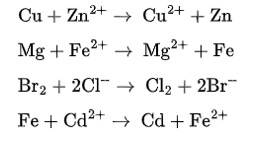Chemistry NCERT Exemplar Solutions Class 11th Chapter Eight
Get insights from 125 questions on Chemistry NCERT Exemplar Solutions Class 11th Chapter Eight, answered by students, alumni, and experts. You may also ask and answer any question you like about Chemistry NCERT Exemplar Solutions Class 11th Chapter Eight
Follow Ask QuestionQuestions
Discussions
Active Users
Followers
New answer posted
5 months agoContributor-Level 10
This is a Long answer type question as classified in NCERT Exemplar
We can calculate the oxidation states by - ]
NaClO4 Oxidation no. of chlorine = +7
Suppose oxidation number of chlorine is x then, 1 + x + 4 * (−2) = 0
∴ x - 7 = 0
x = +7
We can calculate, the oxidation states, as given below-
NaClO3 Oxidation no. of chlorine = +5
? NaClO Oxidation no. of chlorine = +1
? KClO2 Oxidation no. of chlorine = +3
? Cl2O7 Oxidation no. of chlorine = +7
ClO3 Oxidation no. of chlorine = +6
Cl2O Oxidation no. of chlorine = +1
NaCl Oxidation no. of chlor
New answer posted
5 months agoContributor-Level 10
This is a Long answer type question as classified in NCERT Exemplar
Redox couple are given as
Cu2+/Cu and Zn2+/Zn
Mg2+/Mg and Fe2+ /Fe
Br2/Br- and Cl2 / Cl-
Fe2+ /Fe and Cd2+/Cd
New answer posted
5 months agoContributor-Level 10
This is a Long answer type question as classified in NCERT Exemplar
Disproportionate is defined as the reaction in which one compound of intermediate oxidation state converts to two compounds, one of higher and one of lower oxidation states So, to occur such type of redox reaction, the element should exist in at least three oxidation states. So that element present in the intermediate state and it can change to both higher and lower oxidation state during disproportionate reaction. Fluorine is the most electronegative element and a strong oxidizing agent and is the smallest in size of all the halogens. It does not show a positive oxidat
New answer posted
5 months agoContributor-Level 10
This is a Long answer type question as classified in NCERT Exemplar
On the basis of standard reduction potential suggested in the reactivity series (ii) reaction can take place as Mg has more negative value of E? cell. Hence, Mg will be oxidized by losing electron and iron will be reduced by gaining electron.
New answer posted
5 months agoContributor-Level 10
This is a Long answer type question as classified in NCERT Exemplar
The given reaction is a redox change.
2Na (s)+H2 (g)→2NaH (s)
The half reaction is:
2Na (s)→2Na+ (g)+2e-
The other half reaction is:
H2 (g)+2e-→2H- (g)
This splitting of the reaction into two half-reactions automatically reveals here that sodium is oxidized, and hydrogen is reduced. Any substance which loses electron is oxidized and gains electron is reduced hence is the case of sodium and hydrogen atoms respectively. Hence, the complete reaction is a redox change.
Taking an Exam? Selecting a College?
Get authentic answers from experts, students and alumni that you won't find anywhere else
Sign Up on ShikshaOn Shiksha, get access to
- 65k Colleges
- 1.2k Exams
- 679k Reviews
- 1800k Answers

